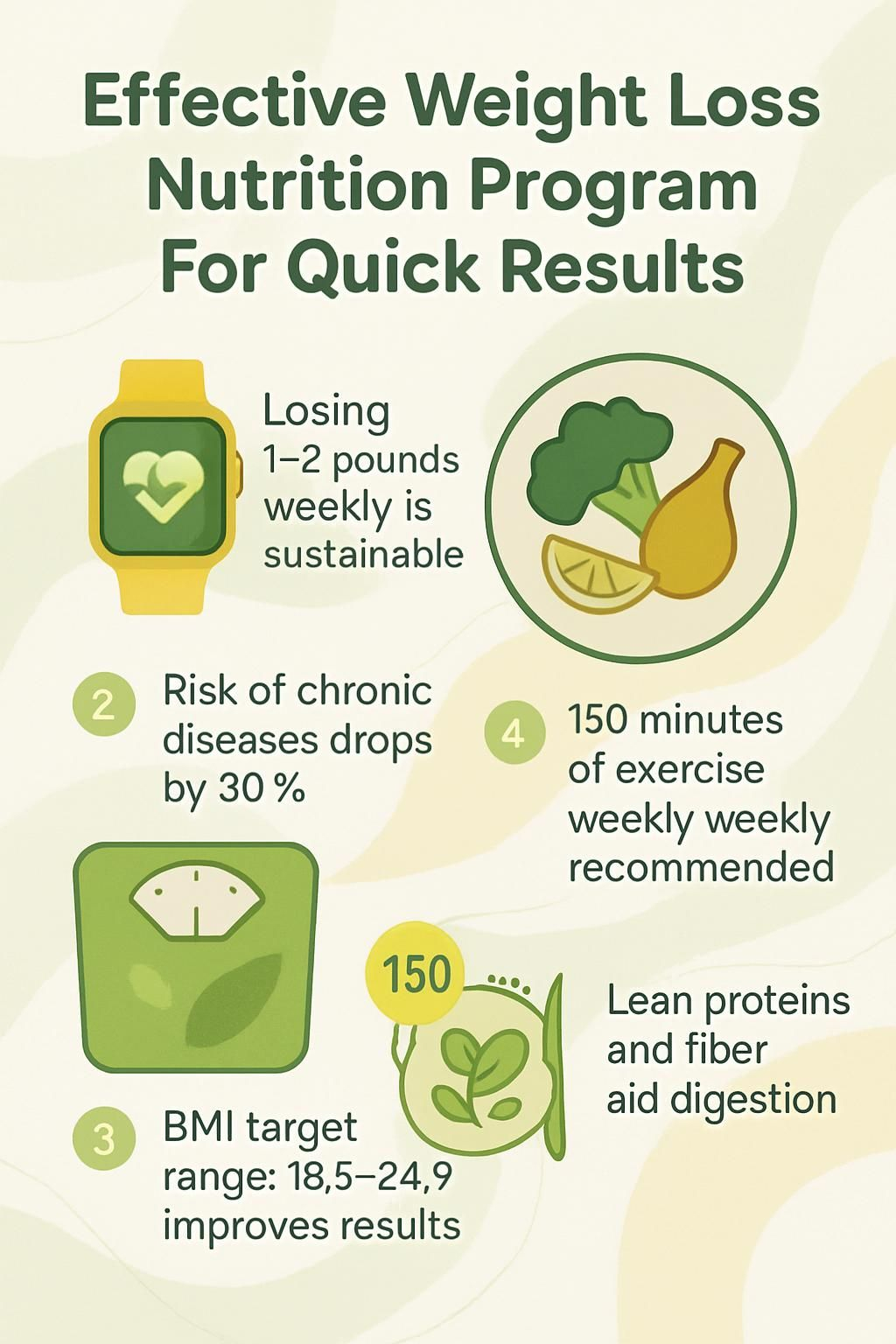Effective Weight Loss Nutrition Program For Quick Results
Our Nutrition Assistant AI Suite will transform your body. You will lose fat, get toned, and build muscle. Gain confidence and optimal health.
Stuck with slow progress? A structured weight loss program can change that. Research shows a clear plan helps you lose weight and improve health faster than dieting without guidance.
This guide walks you through proven programs, practical steps, and daily habits that deliver real results. Use it to take charge of your weight loss journey with confidence.
Key Takeaways
- Safe progress is 1 to 2 pounds per week. This pace supports lasting weight management and better health.
- Mediterranean, DASH, WW, Noom, and plant-forward diets reduce chronic disease risk by about 30% while promoting steady loss.
- Set goals using BMI, target range 18.5 to 24.9. Track calories and habits with apps to prevent regain.
- Lean protein, healthy fats from olive oil or nuts, and high fiber foods increase fullness, protect muscle, and steady energy.
- The CDC advises at least 150 minutes of moderate exercise each week, paired with calorie control, for best fat loss.

What is a weight loss nutrition program?

A weight loss nutrition program is a structured plan for eating and lifestyle that helps you lose excess weight safely. It sets clear nutrition goals, teaches portion control, and organizes meals that are lower in calories yet rich in vitamins, minerals, and fiber.
The best plans focus on whole grains, lean proteins, fruits, vegetables, and healthy fats. This mix protects against nutrient gaps while supporting weight management.
Most programs use a science-based calorie deficit, which means eating fewer calories than you burn. The Mayo Clinic Diet, for example, teaches habit change and portion sizing to support long-term weight control.
Registered dietitians and other health professionals often provide coaching, meal planning help, and activity advice. This guidance keeps your plan safe and personal to your health needs.
Key components of an effective weight loss nutrition program
Strong programs share a few elements that build healthy habits and lasting results. These parts help you reach a realistic goal weight and protect your overall health.
How do you set realistic and achievable weight loss goals?
Clear, reachable goals make success more likely. Use the steps below to set targets that work in real life.
- Find your body mass index, or BMI, to set a healthy range. Most adults aim for 18.5 to 24.9.
- Plan to lose 1 to 2 pounds per week. Faster loss often cuts muscle and increases regain risk.
- Break the big target into small milestones. Start with the first 5 to 10 pounds to build momentum.
- Use measurable data, such as calories, food choices, or minutes of physical activity. Apps make tracking easier.
- Review your medical history. If you have diabetes, high blood pressure, or heart disease, talk with a health care provider first.
- Fit goals to your lifestyle. Busy schedule? Set specific times for short workouts and plan simple meals.
- Check progress weekly. Track inches, body fat, or how clothes fit, not just the scale. Writing weekly notes kept me engaged and motivated.
How can you create a caloric deficit through diet?
A caloric deficit is the gap between calories you burn and calories you eat. It is the core driver of fat loss.
- Estimate daily needs with a calculator from the National Institute of Diabetes and Digestive and Kidney Diseases or ask a clinician.
- Log food with Noom, MyFitnessPal, or the WW International points program to monitor intake.
- Choose nutrient-dense foods that are low in calories and high in fiber and protein. They keep you full.
- Trim portions. Cutting 100 to 200 calories per meal adds up fast.
- Limit processed food and added sugar. These add calories without useful nutrients.
- Swap high-calorie drinks for water or unsweetened tea. Skipping one soda a day can reduce pounds over time.
- Plan meals in advance. Sunday prep kept me on track during busy weeks.
- Boost fiber with beans, lentils, and whole grains to improve fullness and control appetite.
- Read food labels and compare similar items. Small differences can save many calories.
- Use healthy fats like avocado or nuts, but measure them. They are filling and calorie dense.
- Weigh yourself weekly and adjust intake if progress stalls for two or three weeks.
What are the best nutrient-dense foods to prioritize?
Choosing high-nutrient foods makes every calorie work harder. Lean proteins such as chicken breast, turkey, fish, and eggs reduce hunger and protect muscle during weight loss.
Fatty fish like salmon and sardines supply omega-3 fats that support heart health. Greek yogurt and cottage cheese add protein with fewer calories.
Beans, lentils, and chickpeas offer plant protein plus fiber that aids digestion. Whole grains such as quinoa, oats, brown rice, and barley help control blood sugar. Leafy greens, including spinach and kale, deliver vitamins A, C, and K along with iron and calcium.
Colorful vegetables like bell peppers, broccoli, carrots, and tomatoes bring antioxidants that reduce inflammation. Berries give fiber with fewer calories than many fruits.
“Choosing whole foods rich in protein, fiber, healthy fats, vitamins, and minerals can help you lose weight while boosting your health.”
How does regular physical activity support weight loss?
Exercise burns calories and helps create a steady caloric deficit. It also raises metabolism for hours after a workout.
The CDC recommends at least 150 minutes of moderate activity each week, like brisk walking, cycling, or swimming. Strength training two days a week helps keep muscle, which burns more calories at rest than fat.
People who pair diet and exercise tend to lose more and keep it off longer. Enjoy group classes or team sports if that keeps you consistent.
Popular weight loss nutrition programs
Several well-studied plans support sustainable loss and better health. Each uses a nutritious diet to manage weight and reduce disease risk.
What is the Mediterranean Diet?
This eating pattern centers on vegetables, fruits, whole grains, beans, nuts, and olive oil as the main fat source. Fish and seafood are common. Poultry, eggs, cheese, and yogurt appear in moderate amounts, and red meat is occasional.
High fiber and healthy fats support heart health by lowering cholesterol and blood pressure. Studies show a 30 percent reduction in cardiovascular disease risk for people at risk who follow this approach.
If you want a plan that supports long-term weight management and mental well-being, many experts across the United States recommend it.
How does the DASH Diet promote weight loss?
The DASH Diet emphasizes diet quality. You eat more vegetables, fruits, lean proteins, and low-fat dairy, while cutting back on processed foods and added sugars.
This pattern often creates a natural calorie deficit and supports steady loss. Research suggests many people lose 5 to 10 pounds in two months while also lowering blood pressure.
Because the plan is rich in fiber, meals keep you full. When I followed DASH on my doctor’s advice, cravings dropped and energy stayed stable.
People with high blood pressure or insulin resistance may see benefits for both weight and overall health.
What are the benefits of a plant-based diet?
Plant-based meals focus on beans, lentils, whole grains, fruits, and vegetables. These foods are high in fiber, which increases fullness and improves digestion.
Studies show many people who choose plant-based eating consume fewer calories and saturated fats. That makes a calorie deficit easier. You also get vitamins, minerals, and antioxidants that support immune health.
Research from 2022 links plant-based diets with lower risk of heart disease, type 2 diabetes, and high blood pressure. People with polycystic ovary syndrome or frequent weight regain may see improved outcomes. Many also report better energy on nutrient-dense meals.
How does a low-carb diet like Atkins work?
Low-carb plans limit foods high in carbohydrates, such as bread, pasta, and sweets. With fewer carbs, your body uses stored fat for energy.
The early Atkins phase often allows under 20 grams of carbs per day. This is much lower than the Dietary Guidelines for Americans, which suggest 45% to 65% of calories from carbohydrates.
Studies find greater early weight loss in the first six months compared with some low-fat plans. Staples include eggs, fish, poultry, nuts, and seeds. Many people feel fewer cravings and more steady energy.
During my trial of Atkins, sweet cravings dropped and energy felt even between meals. Rapid water loss in the first weeks can jump-start your weight loss journey.
What does WeightWatchers (WW) offer for weight loss?
WeightWatchers, or WW, uses a science-based points program to guide food and drink choices. It nudges you toward nutrient-dense foods and away from calorie-heavy items.
The app includes recipes, progress tracking, group support, and education on nutrition and physical activity. For eligible members, WW can pair coaching with medical weight loss medication.
Flexibility is a strength, which makes long-term weight loss easier while still enjoying favorite foods. The accountability and community help many people stay on track.
How does the Noom psychology-based program help?
Noom is a psychology-based program that helps you change your relationship with food. The app guides daily logging, behavior lessons, and activity tracking.
Its core tools come from cognitive behavioral therapy, a method that helps you identify thought patterns that may be affecting your weight. This can reduce emotional eating.
Coaches offer guidance through chat and email, and brief daily tasks keep you engaged. My experience with Noom showed how small choices, repeated, lead to big changes.
Group coaching and community tools create accountability and motivation. Next, see how intermittent fasting can fit into a healthy plan.
What is intermittent fasting and how does it aid weight loss?
Intermittent fasting, or IF, limits eating to certain time windows and sets fasting periods. A common pattern is 16:8, where you fast for sixteen hours and eat in an eight-hour window.
IF often lowers calorie intake without strict counting. Fasting periods encourage the body to use stored fat for energy, which supports weight loss.
Evidence suggests IF can lower insulin, improve metabolism, and help maintain weight after losing it. Options include daily time-restricted eating or alternate-day fasting. Choose the one that fits your routine.
What are the benefits of following a weight loss nutrition program?
A thoughtful plan helps you lose weight safely and supports long-term health. The sections below show specific gains you can expect.
How does it support sustainable weight loss?
Effective plans teach skills you can keep for life. You learn portion control, food quality, and meal structure that fits your day.
Programs like Noom and WeightWatchers promote steady progress. Losing 1 to 2 pounds per week makes it easier to keep the weight off.
Tracking meals and sleep helped me see that small habits add up. Tools such as meal plans and handouts from a center for weight management increase your odds of success.
Education-based programs, such as Noom or Jenny Craig, build confidence so healthy habits last.
In what ways does it improve overall health?
A structured eating plan can reduce blood pressure, lower LDL cholesterol, and decrease risk for type 2 diabetes and heart disease. Choosing whole grains, produce, and lean proteins supports these gains.
The CDC reports that losing just 5% to 10% of body weight can improve markers linked to cancer and heart health. Replacing sugary drinks with water helps with ways to lose weight and supports immune defenses.
Many insurance policies now support preventive nutrition because it lowers long-term costs and improves health outcomes.
How can it enhance energy levels?
Balanced meals with lean protein, healthy fats, and complex carbs keep blood sugar steady. That reduces mid-day crashes and brain fog.
Nutrient-dense choices like leafy greens, berries, and whole grains fuel your cells. Fewer processed foods and added sugars mean fewer spikes and dips in energy. Staying hydrated helps concentration and stamina.
Many people feel more alert as they shift to real foods. Higher energy often boosts motivation for physical activity, which further supports weight management.
What impact does it have on mood and mental health?
Eating patterns rich in fruits, vegetables, lean protein, and whole grains support brain chemistry. These foods help produce serotonin, a chemical that affects mood.
In a 2017 study in BMC Medicine, adults following a Mediterranean Diet reported fewer depression symptoms than those eating mostly processed foods. Stable blood sugar also reduces stress and irritability.
Programs with coaching and privacy features, like WW or Noom, address habits and emotional eating. Many people notice less anxiety and better sleep within weeks.
From experience, a better diet often means lower stress and more calm. Improved nutrition also reduces the risk of chronic disease.
How does it reduce the risk of chronic diseases?
Following a structured plan lowers risk for heart disease, type 2 diabetes, and high blood pressure. Limiting processed foods and sugar improves blood sugar control.
Fiber from whole grains, fruits, and vegetables helps manage cholesterol and blood pressure. Healthy fats from nuts, seeds, and olive oil support heart protection.
Maintaining a healthy weight after bariatric surgery or lifestyle change further reduces disease risk. After adopting more vegetarian meals and tracking intake, my blood pressure improved.
Evidence shows losing 5% to 10% of body weight can reduce risk for heart disease and diabetes. Nutritious eating paired with weight control is a powerful defense.
Essential nutritional guidelines for quick weight loss results
These guidelines speed progress while protecting health. Use them to prevent weight gain and improve results across any plan.
Why incorporate lean proteins in your diet?
Lean protein increases fullness and supports muscle. More muscle means a higher resting calorie burn.
Chicken breast, turkey, fish, beans, and low-fat dairy deliver protein with less saturated fat than many red meats. They also supply amino acids that support hair, skin, and immune function.
Many experts suggest 20 to 30 grams of protein at each meal. That range helps manage appetite and steady weight loss.
How should you focus on healthy fats?
Healthy fats support your brain and hormones. Good sources include avocados, nuts, seeds, olive oil, and oily fish.
Use small portions at meals. Add sliced avocado to a salad or swap butter for olive oil when cooking.
Research links unsaturated fats with less inflammation and lower heart disease risk. In my loss phase, a handful of almonds or a drizzle of flaxseed oil kept me satisfied and reduced snacking on processed foods.
What fiber-rich foods aid digestion?
Whole grains like oatmeal and brown rice support digestion in different ways. Oats have soluble fiber that softens stool and slows digestion. Brown rice adds insoluble fiber that promotes regularity.
Fruits such as apples, pears, and berries offer extra fiber, especially with the skin. Vegetables like broccoli, carrots, and Brussels sprouts bring fiber plus key nutrients.
Legumes, including lentils and black beans, provide high fiber and plant protein. Aim for a variety each day to keep digestion running well.
How much water should you drink to stay hydrated?
Higher fiber intake increases your need for fluids. Water helps fiber move through the gut and prevents discomfort.
A general target is at least 8 cups, or 64 ounces, each day. Active people and those in hot weather may need more. Some experts suggest drinking half your body weight in ounces.
For a 150-pound person, that is about 75 ounces daily. Thirst, dark yellow urine, or dry lips can signal dehydration and a need to drink more.
Why limit processed foods and sugar?
Processed foods and added sugars make weight loss harder. They tend to be high in calories, unhealthy fats, and sodium, and low in fiber and protein.
People who cut back on sugar lose pounds faster than those who do not. High sugar intake also raises risk for type 2 diabetes and heart disease.
Replacing sweets and packaged snacks with whole grains, fruit, lean protein, and vegetables steadies energy and mood throughout the day.
How do you choose the right weight loss nutrition program?
Choosing a plan that fits your life increases your odds of keeping the weight off. Use the steps below to pick with care.
How do you assess your personal goals and preferences?
Clarify what you want. You might aim to lower body fat, reach a healthy BMI, or improve blood pressure.
Consider your health status, activity level, and any conditions like type 2 diabetes. Review past attempts. Keep what worked, and avoid what did not.
For me, plant-forward meals felt natural, while strict low-carb plans felt too limiting. Matching a plan to your tastes and routine helps you stick with it.
When should you consult a dietitian or healthcare provider?
Talk with a registered dietitian or clinician if you have diabetes, heart disease, thyroid issues, food allergies, or take prescription medication. Seek help for symptoms like fatigue, rapid weight changes, digestive issues, or dizziness.
Professional guidance is also important before starting a very low-calorie diet or using supplements. Meeting a dietitian last year helped me avoid nutrient gaps and fine-tune portions safely.
Early support sets healthy goals and prevents small issues from becoming serious.
Why is long-term sustainability important?
Many people regain pounds after strict diets. A 2018 Journal of Obesity study found frequent regain within two years.
Sustainable plans focus on real habits, not quick fixes. Consistent eating patterns protect metabolism and nutrition while helping you manage social events and busy weeks without feeling deprived.
How can you evaluate a program’s flexibility?
Check if meals can shift with your routine. Flexible plans offer swaps for travel, holidays, and dietary needs like vegetarian or gluten-free.
Look for variety in recipes and meal timing so you can adapt. If mornings are hectic, choose quick breakfasts. If lunch is on the go, plan portable options.
Good programs teach how to handle setbacks and how to get back on track. Flexibility improves long-term satisfaction and success.
What are effective tips for success in a weight loss nutrition program?
Small, steady actions build big results. The tips below make any plan easier to follow.
How can meal prepping and planning help?
Planning meals lowers daily decisions and protects your calorie budget. It also reduces takeout, which often has extra fat, sugar, and sodium.
People who cook at home often eat about 200 fewer calories per day than frequent restaurant diners. Packing snacks and balanced lunches prevents skipped meals and helps protect muscle.
Pre-portion meals to avoid overeating. Use a grocery list to control costs and keep lean protein, whole grains, fruits, and vegetables on hand. Sunday prep helped me lose 10 pounds in three months by sticking to planned portions.
Why is tracking progress important?
Tracking shows what works. Record weekly weight, waist size, and how clothes fit. Even a one-pound drop is a win that fuels motivation.
I kept a simple journal with daily meals and weekly weigh-ins. Over three months, steady but slow changes added up. The data guided smart tweaks.
How do you stay consistent with exercise?
Set a weekly schedule that fits your day. Start small, like 20-minute walks or short home workouts, and build from there.
Use phone reminders or calendar blocks. Track workouts in an app. A partner or class can raise consistency by about 25 percent, according to the CDC.
Mix cardio, strength, and flexibility for balance and interest. Celebrate milestones, such as ten sessions in a row, to reinforce the habit.
How can finding a support system improve results?
Support improves follow-through. Share goals with a friend, group, or online community.
A 2020 Stanford study showed people with social support lost up to 15% more than those who went solo. Weekly check-ins helped me avoid skipping workouts and late-night snacking.
Dietitians and peers can also suggest food swaps and portion tips that fit your lifestyle.
What strategies keep you motivated through small wins?
Track each small win in a journal or app. Set mini goals, such as 2 pounds per week or one extra vegetable each day.
Reward progress with non-food treats, like a new book or a quiet walk. Share your wins with friends or online groups to reinforce positive habits.
What common mistakes should you avoid in weight loss programs?
Avoiding common pitfalls keeps progress steady and reduces frustration. Here are missteps to watch for.
Why avoid setting unrealistic expectations?
Unrealistic goals create frustration and burnout. Expecting to lose 20 pounds in two weeks leads to risky choices and poor follow-through. Healthy loss is usually 1 to 2 pounds per week, based on CDC guidance.
In my first strict plan, slow results made me quit in ten days. Evidence shows that people chasing rapid change often drop out or regain weight soon after stopping^1.
Set goals you can meet. It keeps your mindset positive and your plan consistent.
…
^1 Centers for Disease Control and Prevention (CDC). “Losing Weight.” Updated October 2022.
What are the risks of skipping meals or extreme calorie restriction?
Skipping meals can slow your metabolism and prompt your body to hold onto fat. Very low-calorie diets increase the risk of muscle loss, nutrient gaps, fatigue, and irritability.
Intakes below 1,200 calories for many women and 1,500 for many men may raise risk for gallstones, heart problems, and weak bones. Strong cravings and binge eating can also follow.
Ongoing hunger hurts focus, immunity, and physical activity. These patterns make weight loss harder and less healthy.
How important is portion control?
Portion control is essential. Large servings drive overeating even with healthy foods. People who measure portions tend to lose more.
A 2022 CDC report found adults using smaller plates and measured servings ate about 300 fewer calories per day. Weighing single portions helped me avoid mindless snacking and maintain a steady deficit.
Consistent serving sizes support fat loss now and easier maintenance later.
How do you address emotional eating?
Find your triggers. A food and mood journal can link feelings to eating patterns. Mindful eating helps you pause and check hunger before reaching for a snack.
Use coping tools such as deep breathing, talking with a friend, or taking a short walk. I noticed I grabbed chips during stress. Switching to a five-minute walk reduced those urges within weeks.
Summary: Spot triggers, track moods, and practice simple coping skills to support better choices each day.
Conclusion
An effective weight loss nutrition program combines smart food choices, steady physical activity, and simple daily habits. Focus on nutrient-dense meals, practical planning, and measurable goals you can maintain.
Evidence supports slow, steady progress and routine tracking. Many people benefit from coaching, a registered dietitian, or supportive friends to stay on course.
Small steps, repeated, lead to big change. With the right structure, you can gain energy, improve mood, and lower disease risk. For medical questions or complex conditions, consult a qualified health professional before making major changes.
FAQs
1. What is an effective weight loss nutrition program for quick results?
An effective weight loss nutrition plan uses evidence-based guidelines, such as reducing calorie intake and increasing protein-rich foods like chicken or fish. Studies show that eating more vegetables and whole grains helps people lose fat while keeping muscle mass.
2. How fast can I expect to see results from a structured nutrition program?
Most people who follow a balanced meal plan with fewer calories notice changes within two weeks. Research shows that losing one to two pounds per week is safe and sustainable for most adults.
3. Are there specific foods I should include in my diet for faster fat loss?
Yes, including lean meats, eggs, beans, leafy greens, berries, and oats supports healthy weight reduction. These foods are high in fiber or protein; both help control hunger and support metabolism according to clinical studies.
4. Can personal experience help guide my choice of a nutrition program?
Personal stories often highlight the importance of planning meals ahead and tracking progress daily. For example, after switching to smaller portions of rice at dinner along with extra broccoli or carrots on the side, many individuals report steady improvements in energy levels and body composition over several weeks.
Summary: A successful weight loss approach combines scientific research with practical steps like choosing nutrient-dense foods and monitoring progress regularly. Including real-life examples makes these strategies easier to understand and apply every day.







